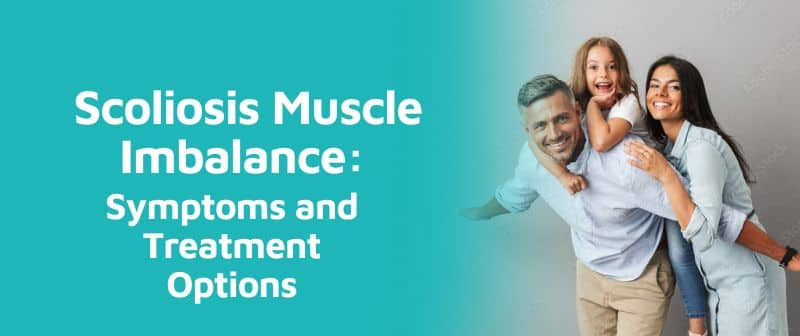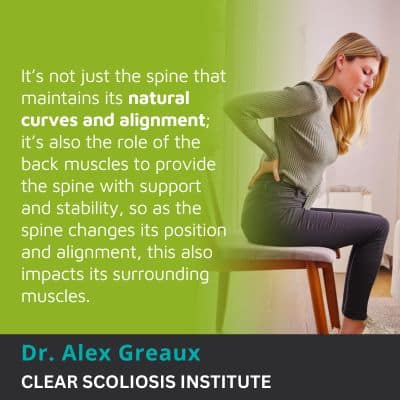
Although scoliosis is a spinal condition, its effects aren’t just limited to the spine alone. An unnatural spinal curve can affect the entire body, along with the spine and its surrounding nerves and muscles; for example, a muscular imbalance can develop as the spine’s surrounding muscles struggle to support its unnatural bend and twist.
Scoliosis is associated with the development of a muscle imbalance. As an unnatural spinal curve develops and progresses, it can pull its surrounding muscles in different directions, causing some to become weak from underuse, while others become tight and sore from overuse.
Before specifically addressing how scoliosis can affect the spine’s surrounding muscles, let’s talk generally about the condition’s uneven forces.
Scoliosis is an asymmetrical condition that involves the development of an unnatural and unhealthy spinal curvature; the spine’s natural curves are key to its strength, flexibility, and function.
If the spine loses one or more of its healthy curves, they are replaced by unhealthy curves capable of disrupting the biomechanics of the entire spine.
The spine is curved at each of its main sections - the cervical spine (neck), thoracic spine (middle/upper back), and the lumbar spine (lower back) - and the health of each spinal section/curve is shaped by the health of the others.
In a healthy spine, its vertebrae (bones) are stacked on top of one another in a straight alignment, but if one or more vertebral bodies become excessively tilted, this shifts them out of alignment with the rest of the spine and can cause an unnatural spinal curve to develop.
As a scoliotic curve develops, it bends unnaturally to the side and also rotates, and this introduces a lot of uneven forces to the spine, the back muscles, surrounding nerves, and the entire body.
The back muscles have three main types: the deep muscles, superficial muscles, and the intermediate muscles.
The deep muscles fuse the spinal column, supporting/stabilizing it, while the superficial muscles facilitate the neck and shoulder’s range of motion; the intermediate muscles help the thoracic cage with movement.
Scoliosis can develop in any of the spine’s sections, or in more than one as a combined scoliosis, but the thoracic spine, the largest spinal section, is the most commonly affected.
Scoliosis doesn't just cause postural changes; it can also affect balance, coordination, and movement.
As the central nervous system consists of the spinal cord and brain, spinal conditions can cause a wide range of symptoms that also affect how the brain communicates with the rest of the body, including its muscles, and the back muscles are important for breathing, structural support, and movement of the entire trunk.

If the spine develops an unnatural spinal curve, it’s no longer balanced and will become increasingly unstable over time, particularly in severe cases, if left untreated, or not treated proactively.
As scoliosis develops and progresses, it disrupts the body’s overall symmetry, and common postural changes can include:
As posture is disrupted, this can also affect balance, coordination, and gait, and what about the spine’s surrounding muscles?
It’s not just the spine that maintains its natural curves and alignment; it’s also the role of the back muscles to provide the spine with support and stability, so as the spine changes its position and alignment, this also impacts its surrounding muscles.
An unnaturally-curved spine can pull the back muscles in opposite directions, causing the development of a muscle imbalance; the muscles on one side of the spine commonly become weak from underuse, while muscles on the opposite side can become sore and strained from overuse.
In typical cases of idiopathic scoliosis, the scoliotic curve bends to the right, away from the heart, known as dextroscoliosis, so the muscles on the right side of the spine are working harder than the muscles on the left to counteract the unnatural bend and twist , becoming stretched.
The muscles on the left side of the spine become weaker, smaller, and tighter from lack of use; if left unaddressed, over time, muscle atrophy can become an issue.
In some atypical cases of scoliosis that are associated with known causes, such as neuromuscular scoliosis caused by the presence of a larger neuromuscular condition (cerebral palsy, spina bifida, and muscular dystrophy), or congenital scoliosis caused by a malformed spine that develops before birth, the spine can bend to the left, towards the heart as levoscoliosis.
In cases of levoscoliosis, the muscle imbalance will be the opposite, with muscles on the left side of the spine being stronger and muscles on the right side of the spine becoming weaker from underuse.
Now that we know how scoliosis can cause a muscle imbalance, let’s address how a scoliosis-related muscle imbalance can affect the body.
When a muscle imbalance develops, one side of the body is stronger than the other, and this can cause a number of effects and potential complications.
As a progressive condition, scoliosis is virtually guaranteed to get worse, and this means the size of the unnatural spinal curve is going to increase over time, as are its effects, and once a muscle imbalance has developed, it will likely get worse alongside progression.
A muscle imbalance can be uncomfortable and painful, and the muscles that aren’t being used can become weaker over time and atrophied (wasting away and/or excessive thinning of muscle tissue).
The more noticeable a muscle imbalance is, the more it needs to be addressed, and the more likely it is to cause mobility issues which can impact overall quality of life.
Firstly, as a structural spinal condition, scoliosis needs to be impacted on a structural level, and as a CLEAR-certified scoliosis chiropractor, chiropractic-centered treatment works towards reducing the curve structurally: through a variety of chiropractic techniques and manual adjustments focused on realigning the spine.
The symptoms and effects of scoliosis are caused by the condition’s underlying structural nature, so this needs to be addressed in order to minimize and/or reverse the condition’s effects, including a muscle imbalance.
A combination of physical therapy and scoliosis-specific exercises (SSEs) target core strength directly while also improving posture, brain-body communication, and addressing any related muscle imbalance that has developed.

When appropriate, corrective bracing is another facet of a conservative treatment approach that’s known to be particularly effective on young patients whose spines are still growing; scoliosis bracing can complement other treatment disciplines by pushing the spine into a more-aligned position.
Rehabilitation is necessary to sustain long-term treatment results, and this can include continued chiropractic care and scoliosis-specific exercises that can be performed from home to continue healing and stabilizing the spine.
Guidance on how to lead a scoliosis-friendly lifestyle is also an important part of treatment, and this includes awareness of activities that are considered safe, those that should be approached with caution, and those that should be avoided.
While activity restrictions are case-specific, a common one is to avoid sports/activities that overuse one side of the body (tennis, bowling) as this can exacerbate a muscle imbalance.
A scoliosis muscle imbalance can develop as the condition’s uneven forces disrupt the body’s overall symmetry, including the muscles that surround the spine.
As a scoliotic curve develops and progresses, the back muscles are having to work harder to support and stabilize a spine that’s unnaturally bent and twisted, and as a progressive condition, condition effects will become more overt alongside progression.
Scoliosis progressing means the unnatural spinal curve is increasing in size, making it more complex to treat; there are no treatment guarantees, but cases that are diagnosed while mild and responded to proactively have shown good results.
Smaller curves are simpler to treat, and in most cases, it’s more effective to apply treatment that has the goal of preventing progression and increasing condition effects than it is to attempt to reverse effects, like a muscle imbalance, once they’re established.
Here at the CLEAR Scoliosis Institute, treatment plans are fully customized around a number of variables, experienced symptoms being an important factor, and if a muscle imbalance is detected, as the structural nature of the condition is being addressed, the focus expands to include strengthening and balancing the back muscles.

CLEAR provides a unique and innovative way of understanding scoliosis. Sign up to receive facts and information you won’t find anywhere else.
